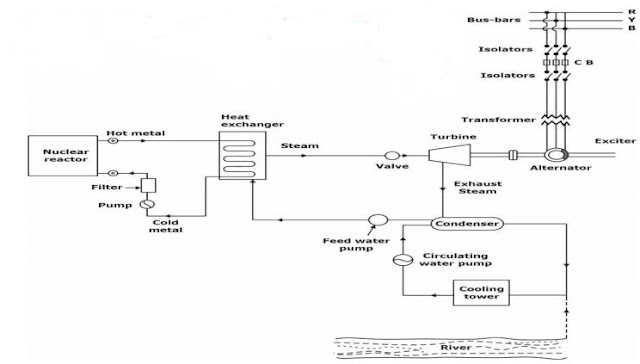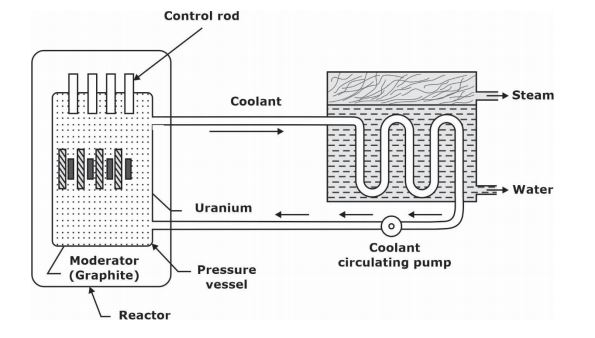Nuclear Power Plant or Nuclear Power Station
Nuclear Power Station:-
A generating station in which nuclear energy is converted into electrical energy is known as a nuclear power station.
Nuclear Reactor:
➢ In a nuclear reactor, the energy is released because of nuclear fission. This energy is absorbed by the hot coolant. The heat exchanger is used for converting water into steam using the coolant and this steam is sent to the turbine for power generation.
Moderator:
➢ It is used to reduce speed of the neutron. The material used as a moderator has low molecular weight. In case of enriched plants, ordinary water is used as a moderator. In case of natural uranium plant, the material graphite, heavy and light water, Beryllium and its oxide is used.
Control Rod:
➢ It is used for absorbing acess neutrons produced during chain reaction. Materials cadmium Boron and Hafnium are used as control rod.
Coolant:
➢ It transfers heat produced inside the reactor to the heat exchanger for conversion of Water to steam.
➢ Materials: Water, Heavy Water, Liquid Sodium, Helium, Co2 or Sodium- potassium alloy is liquid form.
Heat Exchanger:
➢ The coolant gives up heat to the heat exchanger which is utilized in raising the steam. After giving up heat, the coolant is again fed to the reactor.
Note:
1. Complete fission of 1kg of Nuclear Fuel (U235)can produce as much energy as can be
produced by the burning of 275 tons (2,75,000kg) of high grade coal.
2. Nuclear Fuel
➢ Enriched Uranium – U92238– 99.3% of fuel
➢ Natural Uranium – U92235– 0.07% of fuel
➢ Thorium – Th90232
Selection of site for Nuclear Power Station:
1. Availability of Water
2. Disposal of Water
3. Distance from Populated area
4. Transportation Facilities
Advantages
(i) The amount of fuel required is quite small. Therefore, there is a considerable saving in the cost of fuel transportation.
(ii) A nuclear power plant requires less space as compared to any other type of the same size.
(iii) It has low running charges as a small amount of fuel is used for producing bulk electrical energy.
(iv) This type of plant is very economical for producing bulk electric power.
(v) It can be located near the load centres because it does not require large quantities of water and need not be near coal mines. Therefore, the cost of primary distribution is reduced.
(vi) There are large deposits of nuclear fuels available all over the world. Therefore, such plants can ensure continued supply of electrical energy for thousands of years.
(vii) It ensures reliability of operation.
Disadvantages
(i) The fuel used is expensive and is difficult to recover.
(ii) The capital cost on a nuclear plant is very high as compared to other types of plants.
(iii) The erection and commissioning of the plant requires greater technical know-how.
(iv) The fission by-products are generally radioactive and may cause a dangerous amount of
radioactive pollution
(v) Maintenance charges are high due to lack of standardization. Moreover, high salaries of
specially trained personnel employed to handle the plant further raise the cost.
(vi) Nuclear power plants are not well suited for varying loads as the reactor does not respond to the load fluctuations efficiently.
(vii) The disposal of the by-products, which are radioactive, is a big problem. They have either to be disposed off in a deep trench or in a sea away from sea-shore.


No comments:
Post a Comment